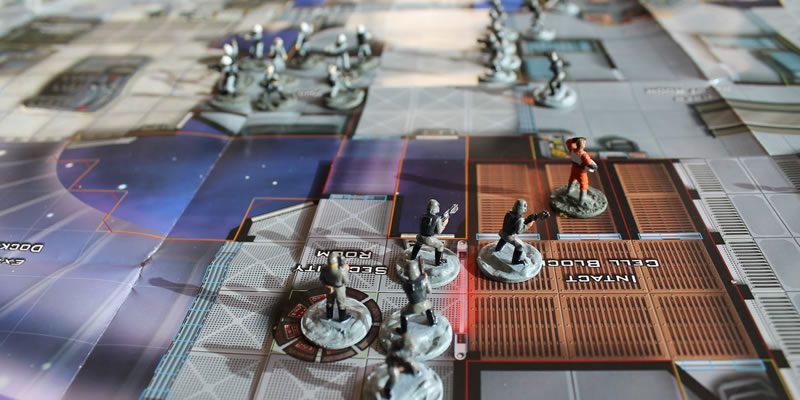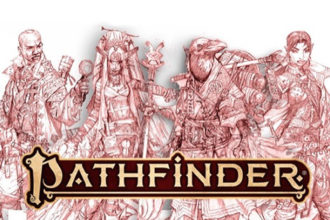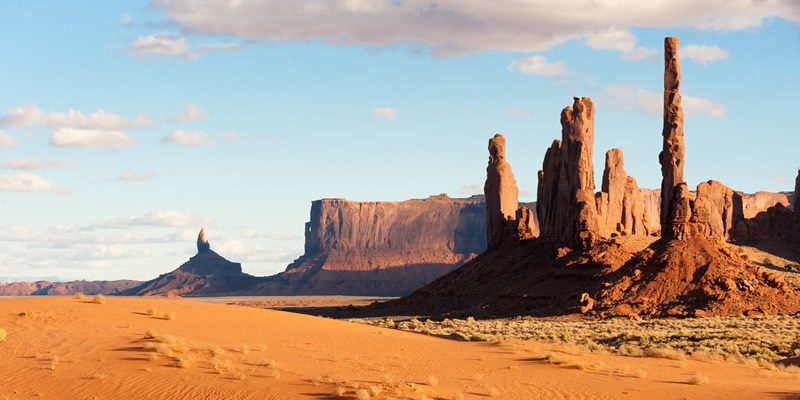Interview with Award-Winning Cartographer Christopher West

Christopher West is best known for his work on the d20 Star Wars RPG and miniatures combat line, as well as both Wizards of the Coasts’ Maps of Mystery project, and Monte Cook’s multiple ENnie-winning Numenera RPG (including the 2014 ENnie for Best Cartography).
Chris currently works freelance for his own company, Maps of Mastery.
The Millennium Falcon
Let’s start off with a question I’ve been dying to ask. One of the things you’re known for is creating the official floor plan for the Millennium Falcon. Didn’t they have one already? How did that come about?
They did. More than one, actually, and that was the problem. There was a lot of contradicting material about that ship and everything inside it, partly because the Star Wars movies never show us the entire interior space, and even the set designs used in filming don’t actually fit within the volume of the ship we see on the screen. Over the years, previous Star Wars RPGs had included some schematics, unrelated products had shown something different, various toys featured their own designs, and even the Incredible Cross Sections books (which arguably presented the Falcon in the most detail at that time) left certain parts obscured.
Various fans had tried to reconcile some of these discrepancies, but they weren’t done in any sort of official capacity and the RPG published by Wizards of the Coast had not, as yet, featured any inside look at this most iconic of vessels. I thought it was time to give players a deck plan they could use in a game, and since I had previously developed new ships for Star Wars Gamer and Polyhedron, I pitched the idea to the editor and got more than I expected: Not only did he like the idea of publishing a new comprehensive map, he wanted me to write an article to go with it.
So I did. I studied everything I could find about the ship’s history and manufacture, and wrote a seven-page feature that consolidated a lot of the known facts and added some new details to fill in the gaps. I don’t think either one of us truly expected Lucasfilm to approve the project for print, but the whole thing passed through their extremely detail-oriented review process without a single change! Ever since then, those deck plans and the article I wrote to go with them have been used as the basis for every official product that has been published about the Millennium Falcon. As a lifelong fan of ships, maps, and all things Star Wars, I can think of no higher honor…
Gaming
Who first got you into gaming? Which game turned you into a life-long fan?
My cousin Tim introduced me to D&D in the early 1980s, and that launched an interest in fantasy gaming that quickly branched out into other genres. I began occasionally DMing with the D&D “red box” and pored over published modules with the hopes of running them–but finding people my age to play with was a challenge. It feels like I spent most of my youth trying to interest others in the game, with little success.
When I got to college, my roommate (who was aware of my interest in D&D, but didn’t really share it) brought me a flyer he had found on campus: a local bookstore called “The Book Shelf” was playing host to several ongoing RPG campaigns. I immediately became a part of the local ‘gaming guild’ and met several friends that I still play with to this day. I even met the woman who would become my wife there, when some of those new friends encouraged us both to try this new “Vampire” RPG.
What is your favorite genre to run?
Though my gaming roots go back to medieval fantasy, Star Wars has always lived at the heart of my imagination, so whenever I have a chance to run a game (or, more rarely, play in one), Star Wars almost always gets my vote.
What is your favorite archetype to play? Is it the same across genres?
In D&D, I gravitate towards spell-casters. In Star Wars, I like playing pilots and scoundrels–anyone with a ship. In Vampire: The Masquerade, I always found myself playing kindred with a deep moral code, trying to resist the darkness within. I guess I’m sort of a “Jack-of-all-trades” when it comes to playing characters–probably because I’m used to playing all of the various NPCs in the background as a Dungeon Master.
What is your all-time favorite RPG (system or setting)? What recent games (past ~5 years) have impressed you by its game design, setting, or cartography?
I really love the narrative dice system attached to Star Wars: Edge of the Empire from Fantasy Flight. The game doesn’t call for maps, but I try not to hold that against it. 😉 Beyond that, it’s hard to pick favorites. I love many different games for many different reasons:
The Dresden Files RPG books cunningly integrate footnotes throughout the text, written from the points of view of characters within the novels. That’s really cool.
Numenera has a unique approach to storytelling, and the setting is impossibly rich with mystery. I love that about it.
I got to work on the star charts for Firefly, and I love the source material, but I haven’t gotten my players on board to play it yet. I’ll have to reserve judgement until we can take the system for a spin.
Cartography
Are you a full-time cartographer and designer, or do you have a “day job”? How do you balance your time between work, family, friends, etc?
I am a full-time cartographer, but it’s safe to say that my “day job” is really “stay-at-home-dad”. As my kids get older and a little less dependent on my attention, I’m finding myself able to dedicate more time for mapmaking work–but I still struggle to juggle the priorities of being a parent, a husband, and an illustrator. My wonderful wife, Angela, has been incredibly supportive throughout my career, and her employment at a local print shop has allowed us to work together in the process of bringing my maps to market. She’s there with me at every Gen Con, and I couldn’t do it without her.
What made you decide to crossover from casual gamer to professional gaming cartographer?
Back when the Alternity roleplaying game came out–a sci-fi multi-genre RPG system that began development under TSR and was published by Wizards of the Coast–I was really impressed with the cartography. Specifically, there was a starship map in the Player’s Handbook that inspired me. I wanted to see if I could create more ships in the same style, so I created a starship map with a similar look, and e-mailed it to Rob Lazzaretti, senior in-house cartographer for the publisher. He was so impressed that he tracked me down in an online chat room that I hosted at the time to give me some very positive feedback and encouragement.
Bolstered by his reaction, I began to build a portfolio of maps that I could take with me to Gen Con. In 2000, just as D&D 3rd Edition launched and the Dragon and Dungeon magazines prepared to switch over to full color production, I met Chris Perkins (Dungeon’s Editor-in-chief) armed with that portfolio of full-color maps, and he immediately started contracting me to do adventure cartography for the magazine. Rob Lazzaretti also began giving me work for the RPG line around the same time, and my career was officially launched!
Wow. Great start. What projects have you worked on recently that have excited you? What can you tell us about what you’re working on now?
The Numenera Ninth World Guidebook just came out, and I’m thrilled to have been able to return to Monte Cook’s fantastic far-future world and chart more of its wonders. That was an amazing opportunity. Likewise, the Primeval Thule setting from Sasquatch Games is about to be released for more game systems (the Pathfinder version is out now!) and I had the great pleasure of working on that. The poster map of the city of Quodeth is one of my best yet!
Right now I’m preparing more new Forsaken Lands poster maps, which should include an underwater sea-floor map for the first time.
Well, that makes this aquatic-campaign designer very happy. Do you have a release date for that yet?
I’m hoping to Kickstart it in early March if I can get it done in time.
Can you tell us a little about your heroes in the industry?
There’s a whole host of cartographers that I deeply respect, but if I start listing them, I’m sure to leave someone out by accident. Instead, I’m going to focus my praise on Chris and Rob, the guys who first recognized my cartography as valuable, and started paying me to make more of it. Chris Perkins, widely respected for his adventure writing and GMing, is also a rock-solid cartographer who makes the cleanest and most useful map sketches I’ve ever had the pleasure of working from. Lazz is a veritable god of the mapmaking art who has worked on just about every brand ever produced by TSR, Wizards of the Coast, and Paizo.
And you’ve gotten to work with them both.
Yes, but not as closely as I’d like. I live in Pennsylvania and these companies are based out in Washington state, so the only time I ever get to see them in person is at Gen Con.
What previous or current job or degree has helped you the most working in the gaming industry?
I have a BFA degree in Graphic Design from Edinboro University of PA, but at the time there were no courses specifically tailored to teach students how to use Adobe Photoshop (which I use for almost everything)–the software was too new. So I more-or-less taught myself how to design in Photoshop and I’ve done my best to stay on top of it. That said, the principles of graphic design that I practiced in college have been applicable to all of my illustration work since, so I consider it money well spent.
Are there any specific games with incredible maps, or resources for gaming cartography you wish everyone would pick up?
Is it too self-serving to nominate my own Distant Outposts map set for this question?
::laugh:: Not at all. That set is incredible. Maps like those are the reason we’re interviewing you.
Honestly, there is so much amazing cartography being published throughout the roleplaying game industry that I can’t keep up with it all. When I first started making RPG maps, cartography with textures and shadows were all but unheard of, and nearly everything was in black and white. Production values today are at a whole new level, and it’s a lot harder to find ways to raise the bar.
Speaking of that, is the jump from gamer to professional different today than it was for you?
I would say so. Illustration software is capable of making much more robust imagery nowadays, and untrained artists have a lot more resources at their fingertips to learn and practice their craft. Professionals have to keep learning new techniques and new ways of doing things if they are to stay relevant and distinguish themselves from newcomers to the field. When I started doing cartography, I could count the number of people doing this professionally on one hand, and could name them just by looking at their work. But as the number of quality RPG publishers multiplied and raised production standards across the board, the need for new talent to produce detailed maps for adventures and setting books has grown as well. Now there’s a whole host of people doing amazing work out there, and I can’t pretend to know who they all are.
Life and the Future
What are your plans for 2015 and beyond?
Well, I want to reprint some out of print maps, but beyond that, I’d like to give the Deluxe Set treatment to more of my product lines. Forsaken Lands III and IV are in the works, and if the kickstarter for those proceeds well enough, there could be a Deluxe Set of those posters that merges them into one sprawling encounter location. The Deluxe Set for Distant Outposts has proven to be a huge success already, and I may even expand the space station to include a whole new deck.
Outside of gaming and cartography, what other hobbies and interests do you have?
Well, I also dabble in other graphic design, having created the packaging and cover art for board and card games like Eons and Edition Wars from Gamer Nation Studios. Beyond that, I voraciously consume sci-fi and fantasy novels, comics, games, TV shows, and other media. I’m also a huge fan of the Marvel Cinematic Universe and can’t get enough of the content they put out!
Beyond all that, I have a deep, spiritual affinity for nature and the outdoor world. I don’t get to immerse myself in that passion as much as I’d like, but a love of the earth and sky and the cosmos around us underpins everything I do in life.
Last question. Some people say they can understand a person by the books they have on their shelves. I feel the same way about games. What are your Go-To games, or what are you playing now?
I recently picked up One Night Ultimate Werewolf, and my friends and family have been having a blast with it. Ticket to Ride is an easy favorite in my home; we have several variations. My son and I have been playing Magic: The Gathering again, and we (and my daughter) like building worlds in Minecraft on the X-box. Within a select group of friends, I really enjoy Cards Against Humanity–but it’s certainly not for everyone. Red Dragon Inn gets played a lot here, and I have exactly one old friend who shares a fondness for Talisman. As for RPGs, I’m currently running two face-to-face gaming groups through my own Star Wars: Edge of the Empire campaign called “The Inheritance Contingency”. I’ve run it before for a group of friends online using Skype and Roll20, and it’s great fun seeing how different groups approach the story and handle the encounters so very differently. I’m also in the midst of a D&D 5th Edition game with another group; we meet rarely, but so far we’ve been enjoying the new system quite thoroughly.
Wonderful. Thanks so much for taking the time to talk with us, Chris. Keep us up to date on your future Kickstarter projects and hopefully we’ll see you at GenCon soon.
——-
To see more of Chris West’s cartography, link over to www.mapsofmastery.com and www.numenera.com, or you can link over to our review of all things West and see why many people consider Chris one of the best in the industry.
If you are lucky enough to attend GenCon, make sure to stop by his booth and check out his work first hand.



